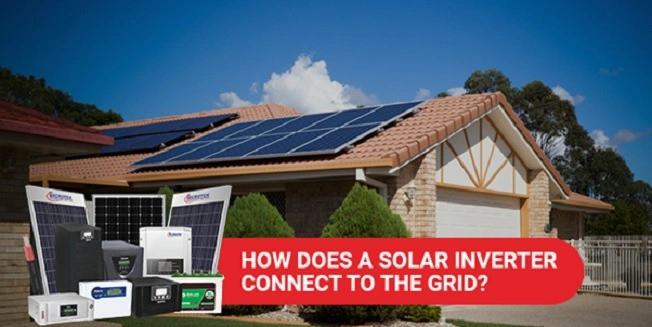
August 19 , 2021

Solar Inverter
As a residential home energy solution, solar inverters are becoming increasingly popular. Many systems rely on photovoltaic solar modules, which convert the sun’s light energy into DC electrical energy.
While hot water exchange is another way to save energy, one could argue that photovoltaic energy exchange is the most easily combined form of “Green Energy” in today’s modern home.
The photovoltaic modules, wiring, and something to keep the generated electricity in the home electrical panel that connects with the power company’s incoming energy supply are the means to make this happen.
An inverter is a device that converts solar energy into electricity.
What is the significance of this device, and why is it named a solar inverter?
The ability of all PV solar panels to supply power in the same manner is one of the most important aspects of their performance. Direct current, or DC, is used to generate electricity. This indicates that the PV module’s output is a constant voltage source that only changes according to the solar cells’ formation and the first shift in the DC output. This is comparable to AC or alternating drift, which is used in the majority of electrical power forms.
What Is a Solar Inverter and How Does It Work?
If you’re new to solar power, or even if you’ve been doing it for a while, you may find yourself scratching your head and wondering, “How does Solar Inverter Work?” So, without further ado, let’s have a look at how a solar inverter works.
Inverters Come in a Variety of Shapes and Sizes. DC electricity is stored in batteries in off-grid applications. The voltage from the batteries is converted into usable AC power via an inverter. The inverter must be able to power all of the appliances and accessories that will be used at the same time, as well as regulate surges.
Grid-tied inverters provide power to the home just when it is needed, while also feeding any extra energy back into the grid. They have advanced detection sensors that ensure they shut down when there is a grid outage or when business workers need to work on the grid.
Inverter technology is constantly improving, with the main drawback being a lack of efficiency, as most inverters operate at just 90 to 95 percent of full power. Understanding the inner workings of an inverter isn’t necessary, but choosing the proper inverter for a specific application is, thus consulting a solar professional or firm about which inverter to buy is highly recommended.
YOU CAN BUY THE BEST GRID TIED SYSTEM HERE
What Are Grid-Tied Inverters and How Do They Work?
In a grid-tied renewable energy system, grid-tied inverters are the most important component. Photovoltaic systems are the most common application for them. Solar panels are used in photovoltaic systems, which are the most efficient and popular source of renewable energy. The phrase “grid-tied” refers to the fact that the house is still connected to the local electricity system.
Grid-Tied Inverter Alternatives
A grid-tied PV system can be built in one of two ways.
The first option is to use a grid-tied inverter that does not require batteries. In this case, your grid-tie inverter converts the solar power generated by the solar panels into usable AC right away. Your inverter uses energy from the grid when the sun isn’t shining. If you generate more energy than you consume, you can sell it back to your utility provider through a system known as net metering.
Using a grid-tied system without batteries makes the system easier to maintain. When these inverters do not detect the grid, they are designed to shut down. This is to protect the people sent to repair downed power lines from any electrical surges generated by the inverter. The inverters can charge batteries and work with the grid, which is the second stage towards having a grid-tied PV system with batteries. Back up battery inverters are the name for these inverters. However, because these inverters are inextricably linked to the grid, they’re sometimes referred to as grid-tied inverters.
If you use the grid with a battery system, the inverter will charge the batteries while the house is powered by the grid collectively. In some circumstances, having batteries in your system provides a backup power reservoir during a power outage.
What Are Grid-Tie Inverters and How Do They Work?
A grid-tie inverter examines the output of the solar panels to which it is connected and connects the feed to the grid. The most typical way is to lightly load the panel and then measure the amount of electricity it receives. If the metric improves, the loading improves as well. The loading is lessened if the measure weakens. So, in essence, the output varies by a modest amount around the board’s maximum power point.
The second step is to channel this energy into a waveform that closely resembles the alternating flow of the grid, allowing current to flow into it and raising the power level to the amount generated by the panel minus exchange losses. The grid frequency and the presence of grid voltage are also identified and adjusted in most systems.
Making the output’s natural frequency slightly higher than the grid frequency is a simple approach to accomplish this. The unit will detect and shut down if the grid is down, if there is aggression, or if there is a catastrophe. Then it will resume after achieving the correct voltage and frequency.
Isn’t that clever? So, even in the worst inverters, there’s a microprocessor doing all of this, and it’s running a dedicated programme.
High-quality models like Microtek GTI 1KW – M11, Microtek GTI 2.2KW – M11, Microtek GTI 3.3KW – M11 and Microtek GTI 5KW – M12 frequently contain a data port that can optionally transmit status and output information to a port connected to the internet for exclusive monitoring.